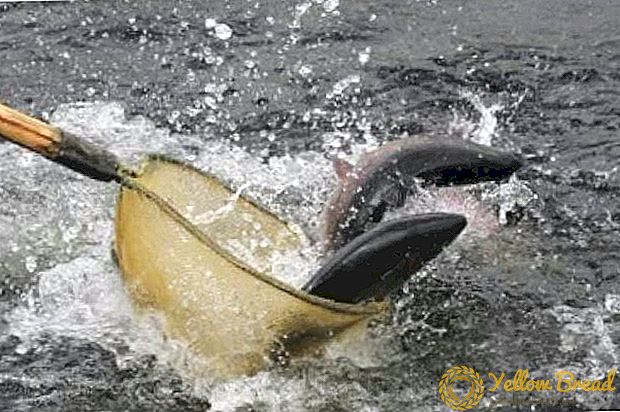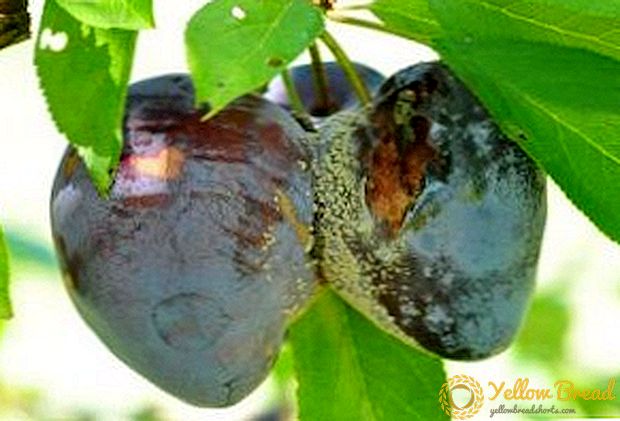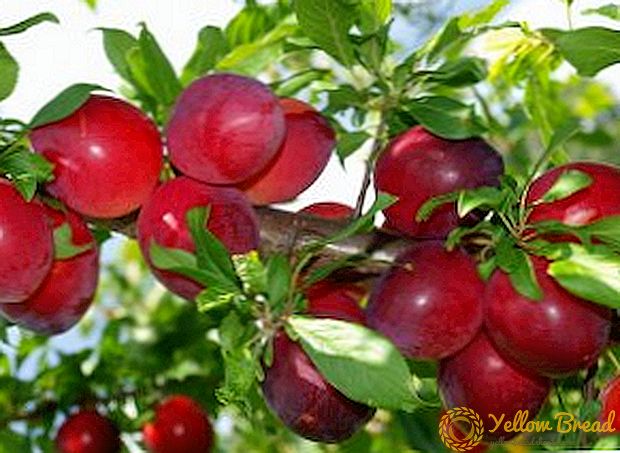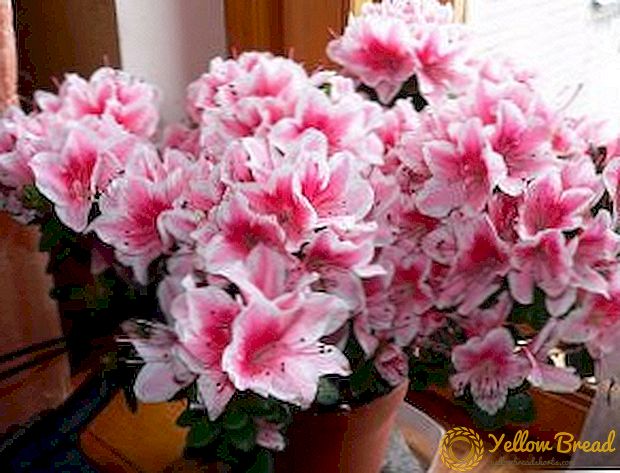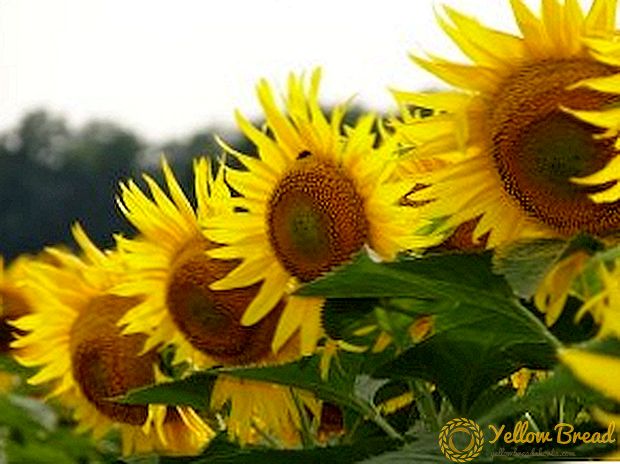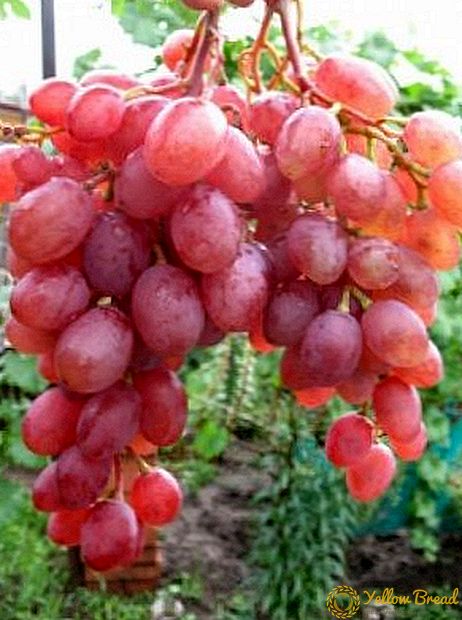
To date, the grapes have ceased to be the plant that could be grown only in warm lands.
Breeders are trying to bring more and more new varieties of these berries, improving their characteristics.
Any gardener who dreams of his own vineyard in conditions of quite severe winters can safely buy Rumba seedlings and not worry about the future harvest.
In addition to its resistance to low temperatures, "Rumba" has many good qualities. The answer to the question "What?" You can find in this article.
Description of the grape variety "Rumba"

The variety of table grapes "Rumba" was created by amateur breeder Kapelyushny V.U. when crossing varieties "Red Delight" and "Charrel".
"Rumba" ripens very early, in just 95 - 100 days, so the harvest can be collected at the turn of July and August. Bushes are very strong, well developed.
Annual shoots can reach a length of about 6 m. The bushes begin to bear fruit two, less often three years after planting. Clusters of cylindrical shape, quite weighty, weight can reach up to 1.5 kg with proper care. The berries are large, oval in shape, 32x24 mm in size, reaching 8 to 10 g in weight.
The flesh is juicy, crunches on the teeth, sweet, sourness is almost absent.You can not worry about the harvest, if you can not remove it in time, because the clusters can remain on the vine without changing the taste. "Rumba" can withstand temperatures down to -25ºС, and is also resistant to fungal diseases.
It has an excellent presentation and easily transports and transports.
Merits:
- ripens quickly
- has excellent taste
- not affected by fungal diseases
- frost resistant
- transportable
disadvantages:
- fruits can be reduced in size with too much load on the shoots
About the features of planting this variety

Shrubs varieties "Rumba" can be planted in any soil, the main thing - the right care.
To the roots of individual bushes was enough space, the distance between them must be at least 3 m.
Due to high frost resistance, seedlings can be planted both in spring and in autumn. The main thing is that at night the temperature does not cross the zero mark.
On a young shoot there should be at least 4 eyes, and the length of this growth should reach 15 - 20 cm.The roots should be cut a little, in the cut they should be white. Preferably, before planting, for a day or two, soak the roots of seedlings in a growth enhancer solution.
For landing you need dig a hole with dimensions 0.8x0.8x0.8 mwhile separating and retaining the upper and lower layers. The top layer should be mixed with organic fertilizers and fall asleep at the bottom of the pit. This layer should fill the space in half. Further, a sapling is lowered into the pit and filled with the ground that was the bottom layer of the pit.
During the landing the ground must be tamped. It is not necessary to completely fill the hole; it is better to leave 5 cm of free space. After planting, the seedling needs to be watered with 2 to 3 buckets of water, loosen the soil after absorbing moisture and cover the remaining 5 cm of the mulch.
Tips for the care of the grade "Rumba"
- Watering

"Rumba" - not very fancy to the amount of moisture grade, therefore standard irrigation scheme.
Watering the bushes is necessary from April to October. After the shoots have been tied up, the first watering is done.
After 2 weeks, after you have cut your grapes, you need to water the bushes again. But if on the branches there was apricot, then watering is prohibited.
When the shoots have grown sufficiently and have reached a length of about 30 cm, the bushes will also need water due to the fact that one of the most active phases of the growing season has begun.
Before flowering and after it, also try to replenish the moisture in the soil. But never water the grapes during flowering, otherwise the flowers will crumble, which will lead to a decrease in yield.
When clusters were already formed on the branches, and the berries had grown to the size of a pea, the time for the next watering came. The last time you need to water the grapes after the harvest, before the shelter. This watering is called water recharge. So you will provide the bushes "Rumba" with enough water.
- Mulching
To keep moisture in the ground as long as possible, it is necessary to mulch the soil regularly. As a material for such a procedure, it is recommended to use organic material, such as straw, old leaves, even grass.
Modern gardeners are also offered special artificial materials, such as mulch paper. They can also be used without fear. It is important that the layer of organic mulch is not less than 5 cm, and the artificial material should be used, following the instructions in the instructions.
- Harboring
Grapes "Rumba" is one of the more frost-resistant, so in the south the bushes can not cover for the winter. But if winters in your region are harsh enough, then you need to worry about protecting saplings and bushes during the cold season.
To cover the vines of each bush you need to bind, lay on the ground and, using special brackets, fasten to the surface. So that during the winter period the shoots do not start to rot or are not affected by various pests, before laying on the soil, you should lay a plastic foam, plywood.
Further, over the entire grape row, iron arcs are installed, for which to stretch the plastic film. On the sides of this film is covered with earth to minimize its movement during gusts of wind. The ends should be left open before the onset of frost, so that the grapes have free access of oxygen.
If for some reason it is not possible to cover the grapes with polyethylene, then this can be done with earth. To do this, the vines are also connected and fixed on the surface, but then they must be sprinkled with earth, and with a large amount, in order to form a mound. In the presence of abundant precipitation in winter, the hills can be covered with snow.
- Pruning

On the bushes "Rumba" can form a lot of shoots.
This means that there will be an excessive load on the grapes, which will lead to the fact that the berries will become small.
Therefore, if you have a young bush, then it should be cut off, leaving 20 bunches.
For an adult bush, the maximum load is 45 holes. Everything extra shoots need to be removed.
If you have a young sapling, then you need to cut it every year, leaving from 3 to 8 lower side branches, which later begin to bear fruit.
Cut shoots need at the level of 4 - 8 peepholes, depending on the age of the bush.
- Fertilizer
"Rumba", like any other grape, needs additional feeding, especially in infertile soils. Therefore, 1 time in 2 - 3 years you need to make organic fertilizers.
The best option would be bird droppings solution, humus, compost. Both organic and mineral fertilizers are introduced into the wells around the bush. These grooves are made around a circle with a radius of 30 - 40 cm, and the depth of one hole should be about 50 cm. Nitrogen is necessary for grapes to increase growth force, so you need to make ammonium nitrate before you open your bushes after winter.
Before flowering, the whole spectrum of fertilizers is applied - superphosphate, potash salt, ammonium nitrate. After flowering nitrogen is not needed. After harvesting, before the shelter, you need to make potassium salt, which will help the plant not to suffer during the cold weather.
- Protection
Despite the resistance of the variety "Rumba" to fungal diseases, annual prophylaxis should be carried out. These protective measures are that the bushes need process phosphorus-containing fungicides before flowering and after it. Measures to combat mildew and oidium in this case are the same.

